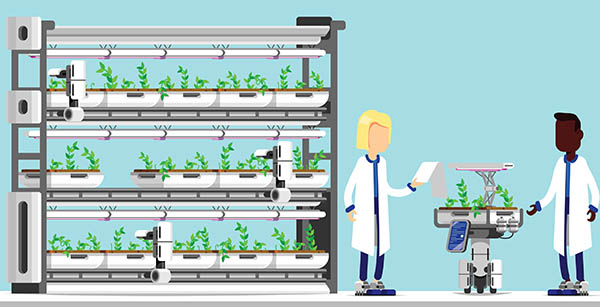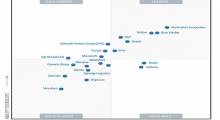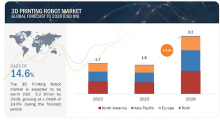An international team of scientists, led by the University of Leeds, has assessed how robotics and autonomous systems might facilitate or impede the United Nations' Sustainable Development Goals.
The group's findings, published in Nature Communications, identify key opportunities and key threats that need to be considered while developing, deploying, and governing robotics and autonomous systems.
The key opportunities robotics and autonomous systems present are through autonomous task completion, supporting human activities, fostering innovation, enhancing remote access, and improving monitoring.
Emerging threats relate to reinforcing inequalities, exacerbating environmental change, diverting resources from tried-and-tested solutions, and reducing freedom and privacy through inadequate governance.
Robots are increasingly playing a bigger role in society
Technological advancements have already profoundly altered how economies operate and how people, society, and environments interrelate. Robotics and autonomous systems are reshaping the world, changing healthcare, food production and biodiversity management.
However, the associated potential positive and negative effects caused by their involvement in the Sustainable Development Goals (SDGs) had not been considered systematically. Now, international researchers have conducted a horizon scan to evaluate the impact this cutting-edge technology could have on SDGs delivery. It involved more than 100 experts from around the world, including 44 experts from low- and middle-income countries.
Lead author Dr Solène Guenat began the research while at the Sustainability Research Institute at Leeds. She is now at the Institute for Landscape Planning and Ecology of the University of Stuttgart. The research was conducted as part of Leeds’ Self Repairing Cities project. This project, concluded in 2021, aimed to enable robots and autonomous systems to maintain urban infrastructure without causing disruption to citizens.
“Robotics and autonomous systems are here to stay and will fundamentally transform how we interact with one another, technology and the environment,” Guenat said.
“This transformation offers many potential benefits for sustainable development. However, realizing those benefits while minimizing unintended consequences is a complex challenge,” Guenat added. “Early identification of possible negative impacts along with early collaboration and continued dialogue across stakeholders will help us seize opportunities while avoiding pitfalls.”
Horizon scanning
Horizon scans have been used to study a wide range of topics, including bioengineering, medicine, and biodiversity conservation. They are increasingly used by private and public organizations worldwide to inform decision-making.
For this horizon scan, the researchers recruited 102 experts in either robotics and autonomous systems and/or the SDGs to participate in online surveys, group discussions and workshops to identify positive and negative impacts robotics could have on delivering the SDGs. The team then evaluated and synthesized the expert responses to determine the key opportunities and threats.
Key opportunities
Replacing human activities: robotics and autonomous systems will take over manual tasks deemed too dangerous, repetitive, or for which labor cannot be found
Supporting human activities: assistive autonomous robotics will work hand-in-hand with humans to facilitate human activities in the work-, private and public-environment
Fostering innovation: technological advances in robotics and autonomous systems will speed up research and development while improving collaborations
Enhancing access: autonomous transport systems, including drones, will facilitate access to remote and/or dangerous areas, ease distance communication, improve supply chains, and transform current modes of transport
Monitoring for decision making: automatic data collection will be used widely with speed and accuracy, and will influence decision-making
Key threats
Reinforcing inequalities: autonomous systems will be unaffordable for most countries and governments, shunned by some due to negative perceptions, and decrease the need for low-skilled labor, thus reinforcing gender and global inequalities
Negative environmental impact: robotics and autonomous systems will have wide-ranging impact on the environment through the use of resources needed for their production, the pollution created by their use and disposal, the landscape simplification they will require, and the disturbance of ecosystems they will provoke
Resource diversion from tried-and tested solutions: robotics and autonomous systems will require large amounts of financial resources to be implemented widely and competition for resources will put other proof-tested measures at risk, especially where goals address socio-political issues
Inadequate governance: a robust and regulatory framework around robotics and autonomous systems use and ownership of the data they collect will not be developed in time, leading to ethical issues and increasing the risk of reinforcing inequalities and negative environmental impact
Despite identifying emerging threats, participants indicated that the impact of robotics and autonomous systems on progress towards the SDGs was likely to be overwhelmingly positive. No SDG was determined to be predominately negatively impacted by robotics and autonomous systems.
However, the future overall impact of robotics and autonomous systems on achieving the SDGs was acknowledged to be hard to predict, especially for goals dealing with inequalities.
“There are already promising ways to mitigate some of the identified threats robotics and autonomous systems could present,”said study co-author professor Martin Dallimer from the School of Earth and Environment at Leeds and the Sustainability Research Institute.
“For example, with issues regarding inequalities, there is a clear need to empower more women and those from diverse backgrounds to engage with robotics development,” he said.
“This, along with greater engagement by engineers with sustainable development professionals would ensure that robotics and autonomous systems are developed and deployed while respecting the needs of multiple different groups,” he added. “Indeed, appropriate mitigation measures to counter the potential negative impacts of robotics and autonomous systems would, by their very nature, contribute to achieving Sustainable Development Goals.”
Planning for the future
The paper highlights warnings that, as of early 2020, insufficient progress was being made towards meeting the SDGs by 2030. The coronavirus pandemic has also stalled some previous progress, for example, by pushing an extra 124 million people into poverty and exacerbating health inequalities.
Mobilizing digital technology could significantly help facilitate the achievement of the SDGs. Yet, the opportunities and threats posed by robotics and autonomous systems are so far not integrated into any other global initiatives, strategies, or social goal setting.
The study authors suggest this is likely in part due to the relatively slow pace of regulation and goal setting when compared to robotics development, leaving the door open to poor regulation or non-binding guidelines.
“Regulatory processes developed in parallel with emerging new technologies are needed to ensure appropriate robotics and autonomous systems,” said study co-author professor Phil Purnell from the School of Civil Engineering at Leeds and Principal Investigator on the Self Repairing Cities projects.
“Although the full impact of robotics and autonomous systems across the Sustainable Development Goals are hard to predict, inclusion of robotics in future iterations of the goals will be essential to avoid detrimental and unintended consequences while realizing the opportunities they offer.”
Article topics
Email Sign Up
















